"二等功年鉴"相关数据
更新时间:2024-10-232019世界能源统计年鉴
In particular,the data compiled in this year's Review suggest that in 2018,global energy demand and carbon emissions from energy use grew at their fastest rate since 2010/11,moving even fur ther away from the accelerated transition envisaged by the Paris climate goals.
BP's economics team estimate that much of the rise in energy growth last year can be traced back to weather-related effects,as farmilies and businesses increased their demand for cooling and heating in response to an unusually large number of hot and cold days.The acceleration in carbon emissions was the direct result of this increased energy consumption.
Even if these weather effects are short-lived,such that the growth in energy demand and carbon emissions slow over the next few years,there seems lttle doubt that the current pace of progress is inconsistent with the Paris climate goals.The world is on an unsustainable path:the longer carbon emissions continue to rise,the harder and more costly will be the eventual adjustment to net-zero carbon emissions.Yet another year of growing carbon emissions underscores the urgency for the world to change.
The Statistical Review provides a timely and objective insight into those developments and how that change can begin to be achieved.
The strength iท energy consumption was reflected acroรs all the fuels,many of which grew more strongly than their recent historical averages.This acceleration was particularly pronounced for natural gas,which grew at one of its fastest rates for over 30 years,accounting for over 40% of the growth in primary energy.On the supply side,the data for 2018 reinforced the central importance of the US shale revolution.
【更多详情,请下载:2019世界能源统计年鉴】
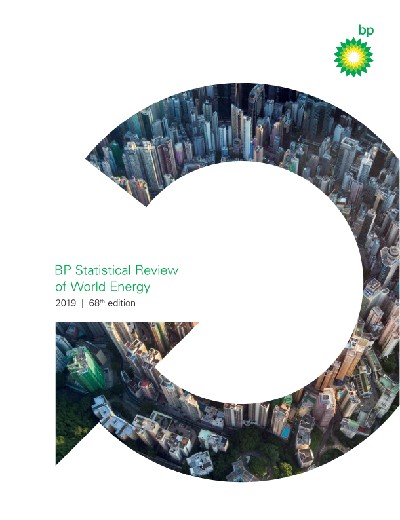
 1928-2017年全球70个国家和地区燃烧产生的二氧化碳燃烧产生的二氧化碳(CO 2)的年排放量,以吨为单位。1928-2017年发布时间:2020-06-12
1928-2017年全球70个国家和地区燃烧产生的二氧化碳燃烧产生的二氧化碳(CO 2)的年排放量,以吨为单位。1928-2017年发布时间:2020-06-12 1902-2017年全球171个国家和地区水泥产生的二氧化碳水泥每年产生的二氧化碳(CO 2)排放量,以吨为单位。1902-2017年发布时间:2020-06-12
1902-2017年全球171个国家和地区水泥产生的二氧化碳水泥每年产生的二氧化碳(CO 2)排放量,以吨为单位。1902-2017年发布时间:2020-06-12 1800-2017年全球229个国家和地区石油产生的二氧化碳石油产生的二氧化碳(CO 2)的年排放量,以吨为单位。1800-2017年发布时间:2020-06-16
1800-2017年全球229个国家和地区石油产生的二氧化碳石油产生的二氧化碳(CO 2)的年排放量,以吨为单位。1800-2017年发布时间:2020-06-16 1855-2017年全球130个国家和地区煤气产生的二氧化碳煤体产生的二氧化碳(CO 2)年排放量,以吨为单位。1855-2017年发布时间:2020-06-16
1855-2017年全球130个国家和地区煤气产生的二氧化碳煤体产生的二氧化碳(CO 2)年排放量,以吨为单位。1855-2017年发布时间:2020-06-16 1751-2017年全球164个国家和地区煤炭产生的二氧化碳煤炭每年产生的二氧化碳(CO 2)排放量,以吨为单位。1751-2017年发布时间:2020-06-12
1751-2017年全球164个国家和地区煤炭产生的二氧化碳煤炭每年产生的二氧化碳(CO 2)排放量,以吨为单位。1751-2017年发布时间:2020-06-12 截至2020年山西省主要年份一、二次能源生产量及构成该数据包含了截至2020年山西省主要年份二次能源生产量及构成。1980年一次能源产量为10310.32万吨标准煤。2020年发布时间:2022-08-08
截至2020年山西省主要年份一、二次能源生产量及构成该数据包含了截至2020年山西省主要年份二次能源生产量及构成。1980年一次能源产量为10310.32万吨标准煤。2020年发布时间:2022-08-08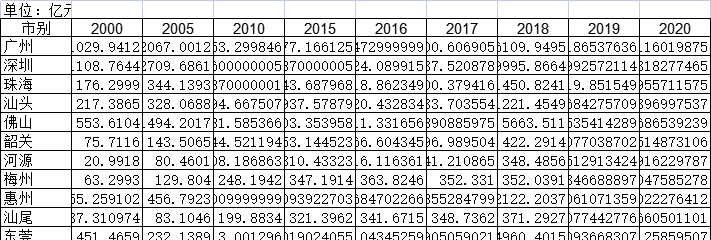 截至2020年广东省各市第二产业增加值该数据包含了截至2020年广东省各市第二产业增加值。广州2000为1029.9412亿元。2020年发布时间:2022-05-17
截至2020年广东省各市第二产业增加值该数据包含了截至2020年广东省各市第二产业增加值。广州2000为1029.9412亿元。2020年发布时间:2022-05-17 1960-2017年全球二氧化碳排放量(千吨)该统计数据包含了1960-2017年二氧化碳排放量(千吨)。2017年二氧化碳排放量为10291926.878千吨。1960-2017年发布时间:2020-07-16
1960-2017年全球二氧化碳排放量(千吨)该统计数据包含了1960-2017年二氧化碳排放量(千吨)。2017年二氧化碳排放量为10291926.878千吨。1960-2017年发布时间:2020-07-16 1960-2014年中国二氧化碳排放来源该统计数据包含了1960-2014年中国二氧化碳排放来源。2014年,固态燃料消耗是二氧化碳的主要排放来源,占比为72.23643%。1960-2014年发布时间:2020-07-16
1960-2014年中国二氧化碳排放来源该统计数据包含了1960-2014年中国二氧化碳排放来源。2014年,固态燃料消耗是二氧化碳的主要排放来源,占比为72.23643%。1960-2014年发布时间:2020-07-16 1960-2017年全球二氧化碳排放量(人均公吨数)该统计数据包含了1960-2017年二氧化碳排放量(人均公吨数)。2014年中国二氧化碳排放量为7.54390764144927人均公吨数。1960-2017年发布时间:2020-07-16
1960-2017年全球二氧化碳排放量(人均公吨数)该统计数据包含了1960-2017年二氧化碳排放量(人均公吨数)。2014年中国二氧化碳排放量为7.54390764144927人均公吨数。1960-2017年发布时间:2020-07-16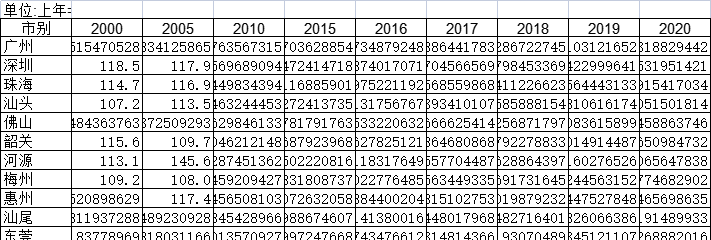 截至2020年广东省各市第二产业增加值指数该数据包含了截至2020年广东省各市第二产业增加值指数。广州2000为111.927515470528。2020年发布时间:2022-05-17
截至2020年广东省各市第二产业增加值指数该数据包含了截至2020年广东省各市第二产业增加值指数。广州2000为111.927515470528。2020年发布时间:2022-05-17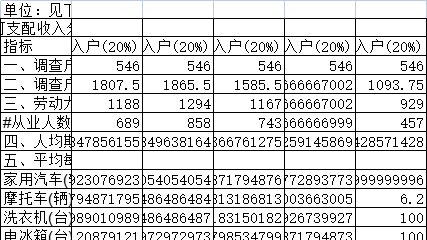 截至2020年山西省城镇居民家庭五等份分组基本情况该数据包含了截至2020年山西省城镇居民家庭五等份分组基本情况。调查户数为546户。2020年发布时间:2022-08-08
截至2020年山西省城镇居民家庭五等份分组基本情况该数据包含了截至2020年山西省城镇居民家庭五等份分组基本情况。调查户数为546户。2020年发布时间:2022-08-08 截至2019年广东省各市第二产业增加值该数据包含了截至2019年广东省各市第二产业增加值。广州2000年1029.9412亿元。2019年发布时间:2021-03-23
截至2019年广东省各市第二产业增加值该数据包含了截至2019年广东省各市第二产业增加值。广州2000年1029.9412亿元。2019年发布时间:2021-03-23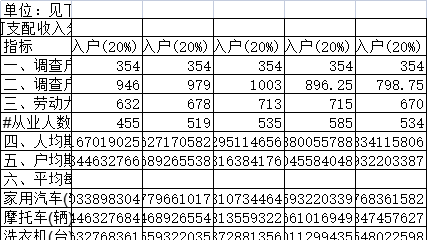 截至2020年山西省农村居民家庭五等份分组基本情况该数据包含了截至2020年山西省农村居民家庭五等份分组基本情况。调查户数为354户。2020年发布时间:2022-08-08
截至2020年山西省农村居民家庭五等份分组基本情况该数据包含了截至2020年山西省农村居民家庭五等份分组基本情况。调查户数为354户。2020年发布时间:2022-08-08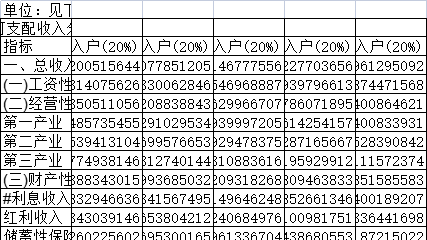 截至2020年山西省城镇居民家庭五等份分组人均收支情况该数据包含了截至2020年山西省城镇居民家庭五等份分组人均收支情况。总收入为15915.708200515644元。2020年发布时间:2022-08-08
截至2020年山西省城镇居民家庭五等份分组人均收支情况该数据包含了截至2020年山西省城镇居民家庭五等份分组人均收支情况。总收入为15915.708200515644元。2020年发布时间:2022-08-08 截至2019年广东省各市第二产业增加值指数该数据包含了截至2019年广东省各市第二产业增加值指数。广州2000年111.927515470528无。2019年发布时间:2021-03-23
截至2019年广东省各市第二产业增加值指数该数据包含了截至2019年广东省各市第二产业增加值指数。广州2000年111.927515470528无。2019年发布时间:2021-03-23 截至2018年广东省各市第二产业增加值该数据包含了截至2018年广东省各市第二产业增加值。广州2000为1029.9412,2005为2067.0012,2010为4078.8965,2012为4828.6714,2013为5377.9799。2018年发布时间:2021-03-03
截至2018年广东省各市第二产业增加值该数据包含了截至2018年广东省各市第二产业增加值。广州2000为1029.9412,2005为2067.0012,2010为4078.8965,2012为4828.6714,2013为5377.9799。2018年发布时间:2021-03-03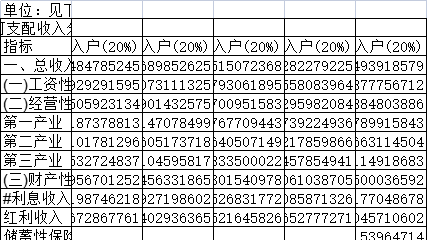 截至2020年山西省农村居民家庭五等份分组人均收支情况该数据包含了截至2020年山西省农村居民家庭五等份分组人均收支情况。总收入为8393.644484785245元。2020年发布时间:2022-08-08
截至2020年山西省农村居民家庭五等份分组人均收支情况该数据包含了截至2020年山西省农村居民家庭五等份分组人均收支情况。总收入为8393.644484785245元。2020年发布时间:2022-08-08 1990-2017年全球二氧化碳排放量(千克 PPP美元GDP)该统计数据包含了1990-2017年二氧化碳排放量(千克 PPP美元GDP)。2014年中国排放量为0.561282712039961千克 PPP美元GDP。1990-2017年发布时间:2020-07-16
1990-2017年全球二氧化碳排放量(千克 PPP美元GDP)该统计数据包含了1990-2017年二氧化碳排放量(千克 PPP美元GDP)。2014年中国排放量为0.561282712039961千克 PPP美元GDP。1990-2017年发布时间:2020-07-16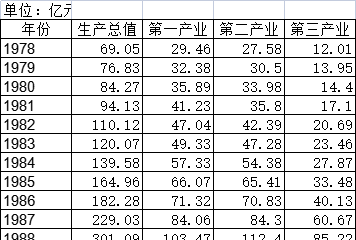 1978-2020年云南省云南生产总值(二)该数据包含了1978-2020年云南省云南生产总值(二)。1978年生产总值为69.05亿元。1978-2020年发布时间:2022-03-30
1978-2020年云南省云南生产总值(二)该数据包含了1978-2020年云南省云南生产总值(二)。1978年生产总值为69.05亿元。1978-2020年发布时间:2022-03-30





